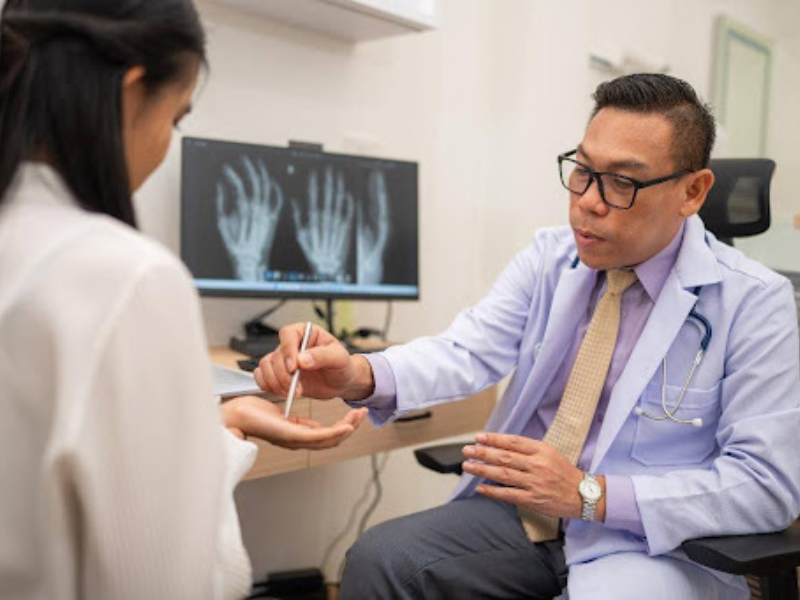
A Comprehensive Guide to Menopause and Rheumatoid Arthritis
Menopause is a significant biological phase for a woman, as she reaches the age of 45 there are potential symptoms of menopause that start showing up. Many women have complained about menopause and arthritis. In particular, some women have also experienced rheumatoid arthritis menopause symptoms, while few experienced joint discomforts due to their hormonal transitory phase. There is a crucial link between menopause and arthritis and how these two conditions interact, as well as their probable symptoms.
Understanding the Link Between Menopause and Arthritis: What is it All About?
Arthritis mostly comes with age, but there are many incidents when woman do not realize arthritis after menopause can either flare up or get worse because of hormonal fluctuations. All symptoms of menopause occur mostly because of hormonal imbalances primarily, a decline in the estrogen level.
Women tend to experience increased inflammation and joint pain, making them more prone to arthritis including rheumatoid arthritis. Estrogen is a hormone that is responsible for maintaining bone and joint health. Rheumatoid arthritis menopause is an autoimmune condition that causes a serious impact on the joints, causing swelling, stiffness, and pain. The increase in this type of arthritis can give women chronic pain.
The impact of reducing estrogen levels can also bring up menopausal arthritis symptoms including fatigue. Therefore, this makes it more important to understand and recognize how menopause and arthritis are intertwined with each other.
Identify Menopausal Arthritis Symptoms: What do You Need to Look Out for?
It is common for women to feel discomfort in their joints while going through menopause as it is a part of their aging, but it becomes crucial to identify the particular menopausal arthritis symptoms early to manage them effectively.
1. Morning Stiffness
The first thing in the morning that women feel is stiffness in their joints, this can be a sign of arthritis rather than just a sign of your aging.
2. Joint Pain and Swelling
Joint pain related to arthritis can reach a worse situation because of inflammation. The swelling in the joints especially around the knees, fingers, and wrists is mostly common.

3. Decreased Range of Motion
As arthritis progresses the flexibility within the joints gets limited, making daily activity more challenging.
4. Fatigue and Weakness
One of the lesser-known symptoms of menopause and arthritis is weakness and fatigue, this occurs when the muscles seem to get weaker and unusually feel tired.
Recognizing these menopause arthritis symptoms can help you have a better quality of life and being attentive to understanding these changes will also make women attentive to any forthcoming health conditions.
Rheumatoid Arthritis and Menopause: Why Does it Flare Up?
Women who already have a history of rheumatoid arthritis might find the symptoms getting worse during menopause. Rheumatoid arthritis menopause flares up because estrogen plays a significant role in moderating the immune system. The decline in the estrogen level can make the immune response in becoming overactive increasing more inflammation in the joints.
There are some potential symptoms of rheumatoid arthritis menopause, a few of them have been listed below:
- Increased joint tenderness and swelling.
- Red warm joints because of inflammation.
- Intense pain in the joints might worsen overnight.
- Fatigue and a general feeling of malaise.
Those who have not experienced rheumatoid arthritis before might show various other symptoms, making this autoimmune condition a potential threat for women in their 40s and 50s.
How Menopause Triggers Arthritis: Know the Hormonal Connection
The link between menopause and arthritis is mostly influenced by the hormonal imbalances in a woman’s body. The estrogen level falls and the inflammation starts increasing making the joint tissues more prone to damage.
Also, estrogen has various protective properties that will help cartilage which is the cushion between the joints. Without sufficient estrogen, women might experience cartilage breakdown leading to painful and rigid joints.
Certain types of arthritis tend to worsen after menopause which include:
1. Osteoarthritis
This is also known as “wear and tear” arthritis, osteoarthritis impacts the cartilage leading to stiffness and pain in the joints.
2. Rheumatoid Arthritis
As said above, rheumatoid arthritis menopause flares are very usual which gradually leads to widespread inflammation.
3. Gout
This is another form of arthritis that is common during menopause because of increased uric acid levels which causes a sharp pain in the feet and the toes.
Hormonal therapy or any kind of medication can at times aid in managing these conditions, but the changes in the lifestyle and natural remedies can also have a significant role.
Can Arthritis After Menopause Be Treated Naturally? Yes, it is Possible! Know How
While medications are an option, many women also have taken the help of natural treatments to reduce the pain of menopausal arthritis, minimize the side effects, and improve overall health. Fortunately, several natural treatments can help reduce inflammation and joint pain during menopause.
Listed below are some effective menopausal arthritis natural treatments to consider:
1. Dietary adjustments: Anti-Inflammatory Foods
A well-balanced, and anti-inflammatory diet can bring a significant difference in handling arthritis after menopause. Focus on foods that can reduce inflammation such as:
- Omega-3 rich fish such as salmon and mackerel.
- Leafy and green vegetables such as kale and spinach.
- Berries are filled with antioxidants.
- Seeds and nuts particularly flaxseeds and chia seeds.
2. Supplements for Joint Health
Certain supplements are highly effective in treating arthritis after menopause. Consider the following in your daily routine to seek your relief:
- Glucosamine and Chondroitin: this helps in repairing cartilage and reducing joint pain.
- Turmeric: The active compound curcumin in turmeric has essential anti-inflammatory properties.
- Collagen: Boosts joint health and decreases stiffness, making it most reliable for women suffering from arthritis during menopause.
3. Exercise and Movement
Keeping yourself engaged in physical activities will help you stay active and fit, it is one of the best ways to manage menopausal arthritis symptoms. Low-impact exercises such as cycling, yoga, and swimming can help you keep your joints flexible and reduce stiffness. Strength training also helps in maintaining muscle mass, which supports the joints.

4. Stress Management
Chronic stress can increase the symptoms of arthritis, especially in those who experience rheumatoid arthritis. This incorporates stress-relieving practices like meditation, spending time in nature, and deep breathing exercises. Acupuncture and massage therapy can also be a part of your menopausal arthritis natural treatment plan.
5. Hydration and Weight Management
Hydration is also very important for maintaining joint health as it keeps the joints lubricated while maintaining a healthy weight and decreases heaviness on weight-bearing joints such as hips and knees. Both of these aspects can also eliminate the symptoms of arthritis after menopause.
Seek Professional Assistance: When to Consult a Doctor
While there are some natural remedies there are some lifestyle changes that are necessary to adopt, also you can take the help of healthcare professionals as well. If menopausal arthritis symptoms can become worse or if you suspect that you are experiencing rheumatoid arthritis, it’s important then for you to consult a doctor.
Hormone replacement therapy (HRT) is also one of the most effective solutions to bring balance to the hormonal level. The estrogen level also gets stabilized with this procedure.
Key Takeaways
Menopause and arthritis go hand-in-hand because of the aging factor. The problems in the joints do arise but at times the pain and conditions get worsened. You must understand the remedies and the changes that occur because of menopause.
There are treatments available that will help you cope with the pain but even you have to bring certain changes in your lifestyle and diet to ensure a healthy and quality life. Get yourself engaged in physical activities such as exercising, swimming, and yoga to keep your joints healthy, and even try meditation and other stress-managing exercises for a better life.
Citations
- https://academic.oup.com/rheumatology/article-abstract/57/5/798/4810410?login=false
- https://academic.oup.com/pmj/article/77/907/292/7039494
- https://academic.oup.com/rheumatology/article/61/4/1303/6427649?login=false
- https://link.springer.com/article/10.1186/s12905-020-01164-6
- https://link.springer.com/article/10.1186/s12905-023-02612-9

Prativa Chatterjee





